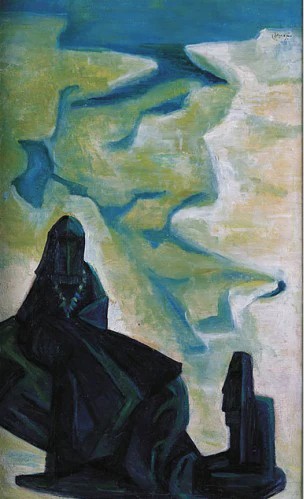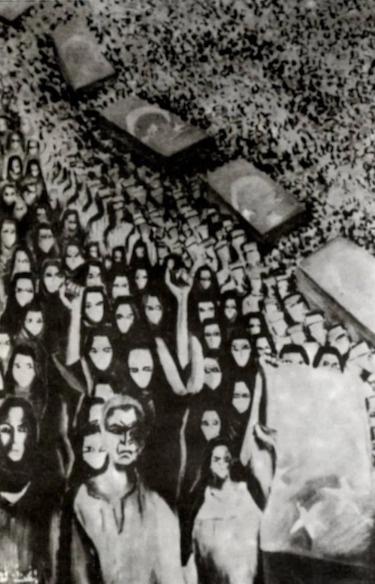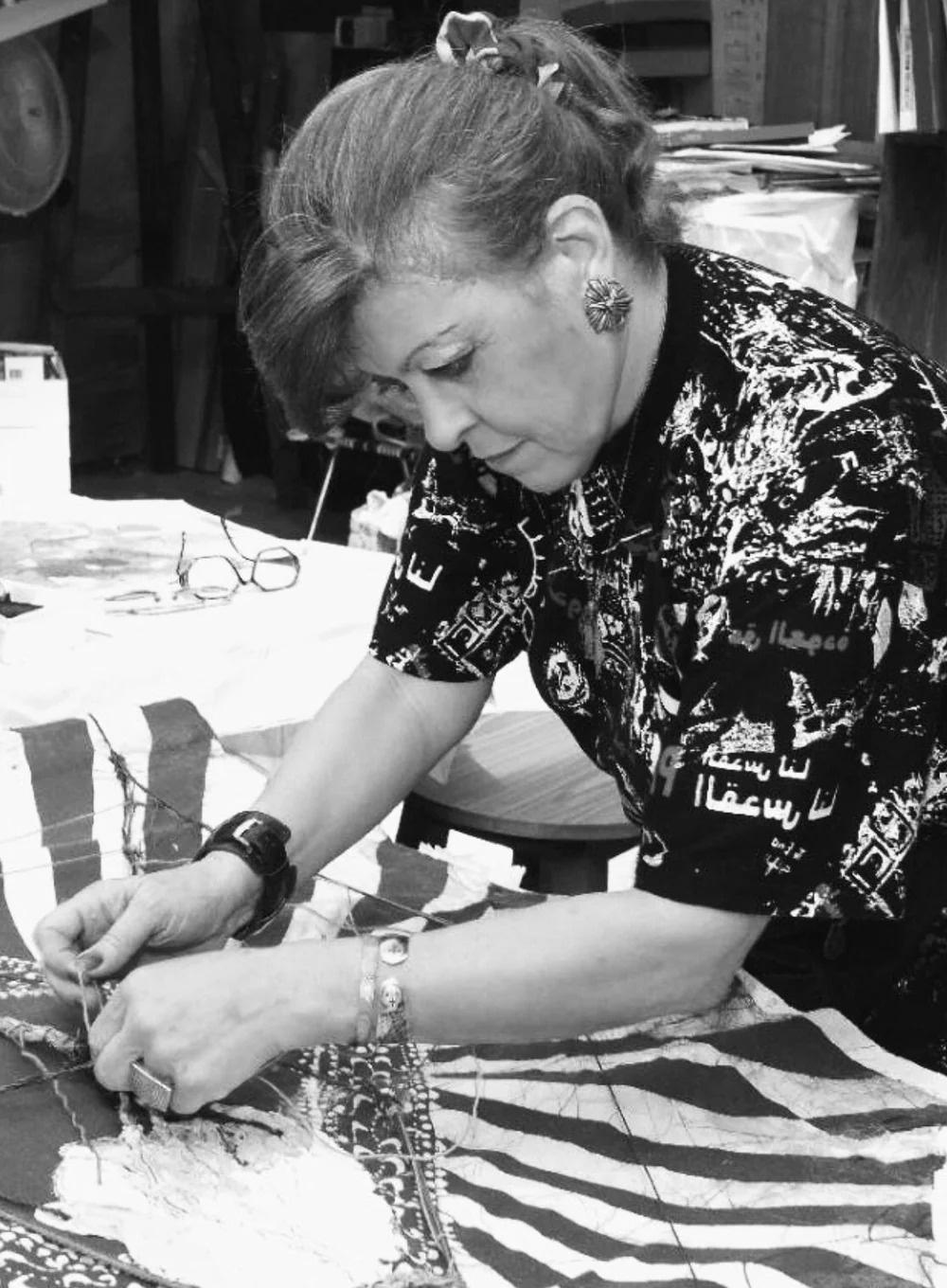
Born in Mecca, Saudi Arabia, Mounira Mously (1954-2019) studied art at the School of Fine Arts in Cairo. There, she was under the tutelage of the great giants in the Egyptian plastic art movement, including Hamed Nada, Abdel Hadi Jazzar, Abdel Aziz Darwish, Hussein Hamouda, Zainab Al-Sijini, and others who shaped the legacy and heritage of the modern art movement in Egypt. She graduated in 1974 and continued her studies in the United States of America, obtaining a diploma in design art in 1979. It was at that point she returned to the Kingdom of Saudi Arabia to work for Saudi Aramco as a publication design specialist.
Though little scholarship has examined her artistic career, Mously's homecoming ushered in a new wave of creative expression that cultivated her attention to the interconnectivity between art and activism. Throughout the 1980s and 1990s, Mously centered her artistic production on modes that allowed her voice, culture, and politics to surface and resonate. In doing so, she broke new ground for women artists in the twentieth century and enjoyed a career whose reach stretched far beyond the Middle East. Participating in dynamic exhibitions, such as "Art from Arab and Islamic countries" (1991) at London's Barbican Centre, and the monumental Arab women's exhibition "Forces of Change: Artists of the Arab World" (1994) at the National Museum of Women in the Arts in Washington, D.C., Mously paved the way for the first generation of women artists in Saudi Arabia along with her colleague Safeya Binzager. In 1968, they were the first two female artists to host an exhibition in Jeddah in Dar Altarbyah Alhadeetha School for Girls.

The brochure of the first exhibition with late artist Mounirah Mously in Jeddah Dar Elhanan school
Mously was also part of "The Formative Art Friends in G.C.C", an art group that comprised around 20 artists from around the Gulf. Those who knew her personally agreed that Mounira had a bold and unapologetic personality; she was a fierce woman with strong opinions and brave political stances. Mously's art also became her platform to speak out about political injustices and social issues. An adamant supporter of Palestine and left heartbroken following the Iraq invasion in 2003, Mously was deeply connected to the Arab region's political issues; she felt as if her role as an artist was to utilize her platform to shed light on these tragedies. She used her art network to raise money and attention for charities that helped Palestinian families through her exhibitions.
Mously's work as an artist, humanist, and activist positioned her as an inspiration for other women seeking to break the proverbial "glass ceiling" imposed upon them. Her art was a reflection of her love and appreciation for all cultures. She was deeply connected to both her art and her culture, once saying "I belong to all civilizations, all races, all arts and all times. I was born with them and will die with them too." This combination made her pivotal to the rise of future Saudi women artists.

Mounira Mously, “The Land of Solidites”, 1970. Courtesy of Barjeel Art Foundation
Of the generation prior to Mously, Inji Efflatoun, a painter, communist, and women's rights advocate, was born in Cairo, Egypt, in 1924. Her life was marked with phases of color, agony, and rebellion, all of which contributed to her groundbreaking artwork. From a privileged upbringing, Inji grew up in a French-speaking nobility in Cairo. She was educated in a strict Catholic school before attending the French high school in Cairo, and her life found its way to social activism and fighting for women's rights. Inji spent around 15 years lobbying for women's rights. She was perhaps the first woman to focus on empowerment at Cairo College. In 1945, she had left-wing and anti-colonialist leanings, and she helped found the Young Women's Academic League and Institutes, which advocated for gender equality. Her Surrealist artworks relayed her dreams and fears, and her masterpieces painted in prison depict the lives of marginalized people. Efflatoun's life and art were all about change, revolution, and reflecting harsh realities. Her life took a turn when Egyptian painter Mahmoud Said spotted talent and potential in her when she was just 15 years old. Kamel El-Telmessani mentored her, and she went on to stun him with bold colors and vigorous expression. El-Telmessani was a founding member of the rebellious Egyptian Art and Freedom Group movement (Art et Liberté), which aimed to use art to liberate minds and nations. Their ethos centered around promoting modernization with roots in Egyptian heritage, social reform, and collective freedom through art. Efflatoun absorbed this influence from her mentor, contributing as an artist as well as an advocate of the movement.
Inji Efflatoun “We cannot forget, 1951”. Courtesy of Anneka Lenssen (Lenssen 2016)
Efflatoun despised her affluent upbringing and took it upon herself to use her privileges to be the voice of the marginalized in her community. Her paintings typically evoke a sense of melancholy and reflect the hidden dystopian realities of the wretched Egyptian working class. Although she was a fan of Egypt's President Jamal Abdel Nasser (1956-1970) and optimistic about his socialist remarks and positions, she was disappointed by his crackdown on critics and the atmosphere of censorship created by his regime, which targeted intellectuals and activists.
Inji found herself compelled to self-exile and went into hiding to avoid imprisonment. It was Nasser's actions that forced Efflatoun to conceal herself and lay low in the rural areas of Egypt. Inji was imprisoned for four years (1959-1963) for her communist stances and her avid activism. In Ayad's The New York Times article, which explores the life of the late artist, she notes, "Nasser had clamped down on critics of his regime, forcing Efflatoun to go into hiding. She veiled herself, dressed as a peasant, and lived alone in close quarters, where she continued to paint.
Nevertheless, she was caught by the police in 1959 and imprisoned for her communist activities." (Ayad, 2021.) "Prison was a very enriching experience for my development as a human being and artist" Inji told Betty LaDuke (LaDuke, 1992). "When a crisis or tragedy occurs, one can become more strong or be destroyed. I became more open to people's life. Before, I didn't compromise. Now, if I see someone's weakness, I accept it."

Inji Efflatoun (Egypt, 1924–1984) In the Women's Prison, c. 1960. From her period in prison
Though coming from different backgrounds and part of divergent artistic circles, Mously and Efflatoun both shared an unwavering compassion for those exposed to injustices. Mounira Mously focused on raising awareness and support for Palestine. Through her exhibitions and artwork, she brought attention to the struggles of Palestinian families and helped raise money for charities that supported them. Meanwhile, Inji Efflatoun fought for the rights of women and children, shed light on the class struggles within her country, and stood by those who had been stripped of the capacity to have a voice within the social and political sphere in Egypt. Both artists harnessed the power of their art to speak out about political and social injustices, and their activism through art proved a powerful mechanism to challenge societal norms and push for positive change. They were the definition of activist artists, and their trailblazing careers proved groundbreaking for women artists in the Arab world who were inspired to follow in their footsteps.
References
Aksoy Farah Zeynep Fatenn Mostafa Nabaraoui Céza and Green Art Gallery. 2017. Modernist Women of Egypt : Inji Efflatoun Vessela Farid Tahia Halim Zeinab Abdel Hamid Effat Naghi Marguerite Nakhla Gazbia Sirry Margo Veillon. Dubai: Green. Art. Gallery.
Ayad, M. n.d. "Overlooked No More: Inji Efflatoun, Egyptian Artist of the People." The New York Times.
LaDuke, Betty. "Inji Efflatoun Art, Feminism, and Politics in Egypt." Art Education 45, no. 2 (1992): 33-41. https://doi.org/10.2307/3193323.
Lenssen, Anneka. 2016. "Inji Efflatoun: White Light." Afterall: A Journal of Art, Context and Enquiry 42 (September): 84-95.
Wilson-Goldie Kaelen. 2019. "Public/Private: The Many Lives of 'Rebel Painter' Inji Efflatoun."
Afterall: A Journal of Art Context and Enquiry 132-45. https://doi.org/10.1086/706135.